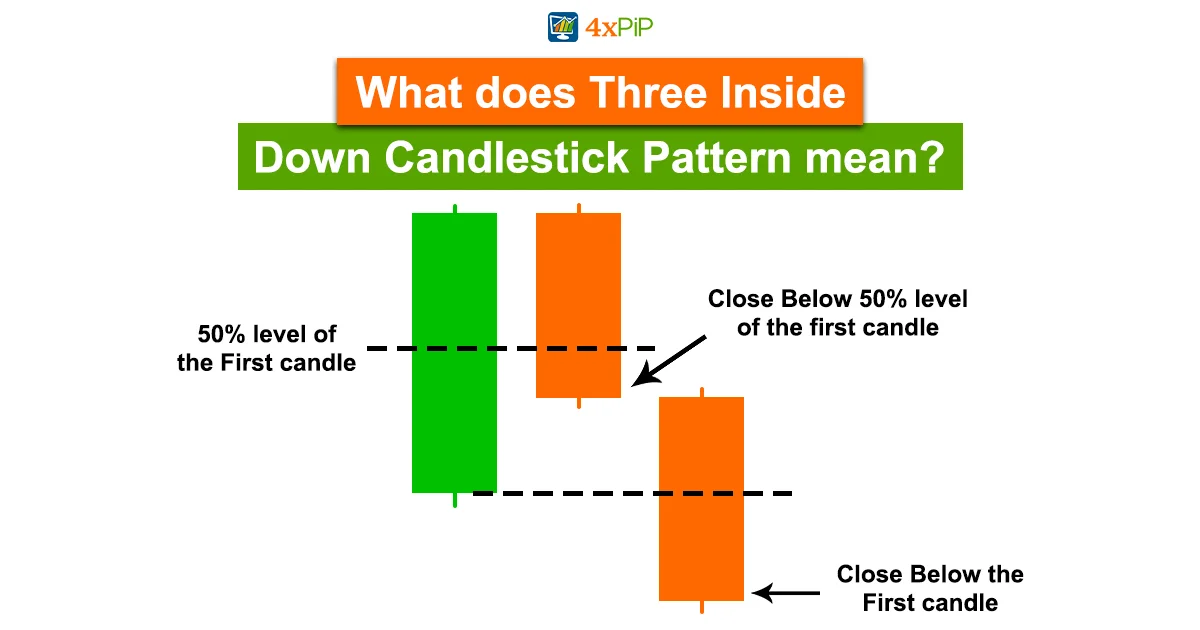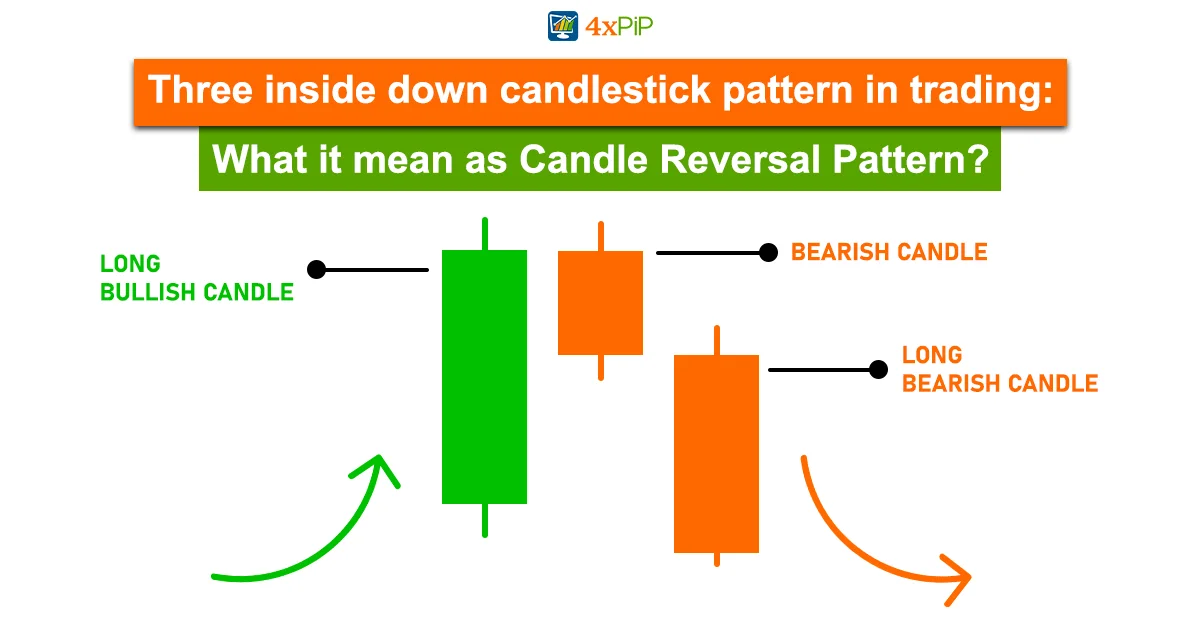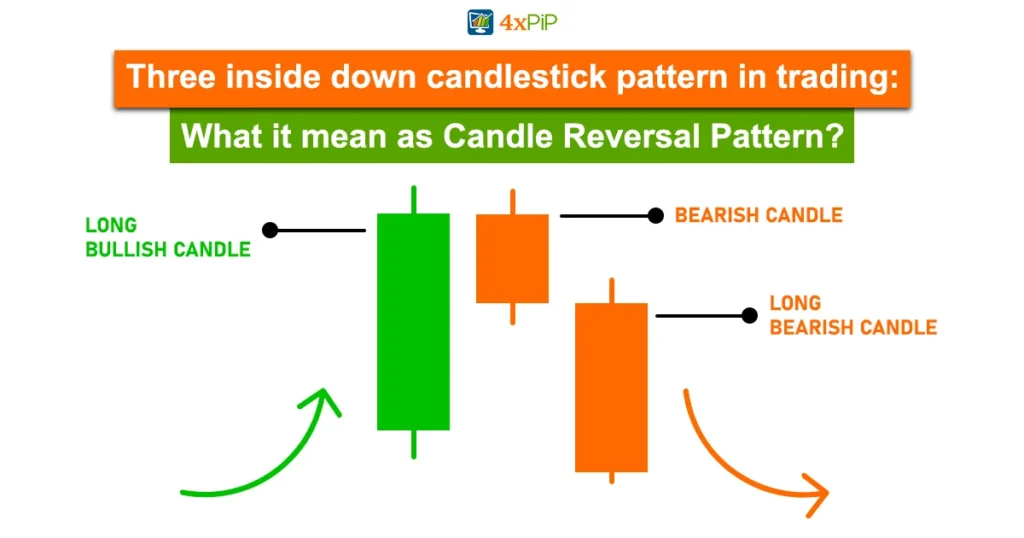Learning candlestick patterns is one of the most critical steps in becoming a profitable trader. One such pattern is the Three Inside Down candlestick pattern, which can offer insightful information on market reversals. Throughout this guide, we will explore the anatomy of the Three Inside Down pattern, discuss its significance in different market contexts, and provide practical tips on integrating it into your trading strategy with 4xPip. 4xPip’s auto-trading EAs take the guesswork out of the equation. Expert Advisors automatically scan the market, pinpoint these bearish whispers, and execute trades precisely, maximizing your profit potential based on this powerful signal. Get ready to take your trading to the next level.
What Does Three Inside Down Candlestick Pattern Mean?

The Three Inside Down pattern is a bearish reversal pattern that consists of three candles. It signifies a potential shift in market trend from bullish to bearish, suggesting that the uptrend may end. This pattern typically forms after a strong uptrend, indicating that the bulls are losing control and the bears are gaining momentum. The pattern is characterized by the following:
- First Candle: The first candle is a large bullish candle, indicating a strong uptrend.
- Second Candle: The second candle is a smaller, bearish candle that closes within the first candle’s body.
- Third Candle: The third candle is a bearish candle that closes below the first candle’s low, confirming the reversal.
The Three Inside Down pattern suggests that the bears have taken control, and a potential downtrend may follow. The third candle closing below the first candle’s low reinforces the pattern’s strength, confirming the bearish trend. This provides a reliable entry point for traders anticipating a downtrend. It also serves as an exit signal for those in long or buy positions, enabling them to safeguard gains or mitigate losses. Identifying the Three Inside Down pattern on a candlestick chart requires a keen eye for detail and understanding its formation.
Formation of Three Inside Down Candlestick Pattern:
Consider the relationships between the candles and their specific characteristics to successfully identify the Three Inside Down pattern on a candlestick chart. Here’s a step-by-step guide to identifying this pattern:
- Step 1: Assess the Trend: It’s essential to determine the prevailing trend before looking for the Three Inside Down pattern. This pattern is typically observed after a strong uptrend, so identify a bullish trend before proceeding.
- Step 2: Look for the First Candle: The first candle in the pattern should be a large bullish candle, indicating a strong uptrend. The body of this candle should be significantly more significant than the previous candles.
- Step 3: Identify the Second Candle: The second candle is a smaller, bearish candle that closes within the first candle’s body. This candle signifies a potential loss of bullish momentum.
- Step 4: Confirm with the Third Candle: The third candle is a bearish candle that closes below the first candle’s low, confirming the reversal. This candle confirms the shift in sentiment from bullish to bearish.
To increase the reliability of the Three Inside Down pattern, traders often look for additional confirmation signals, such as bearish candlestick patterns, trendline breaks, or the convergence of other technical indicators like MACD and RSI. By understanding the formation and implications of this pattern, you can gain a competitive edge in your trading decisions.
How to Trade Three Inside Down Candlestick Patterns?
The psychology motivating traders behind the three inside-down candlestick patterns is that the upward trend persists in the initial candle, marked by a substantial rally that achieves new highs. Subsequently, the next candle opens within the trading range of the preceding one but concludes below both the prior close and its own open. This development triggers apprehension among buyers, potentially prompting them to divest from their long or buy positions. As a result, the third candle finalizes a bearish reversal, compelling additional long or buy positions to contemplate selling, while opportunistic short-sellers may seize the chance to capitalize on the declining price.
Trading the three inside-down pattern is optional; its primary utility lies in alerting that the short-term price direction might be changing.
For those choosing to trade it, in a bearish three inside down, one can initiate a short position towards the end of the third candle day or at the opening of the following day. Positioning a corresponding stop loss above the high of the third, second, or first candle is recommended. Profit targets are not inherent to these patterns, necessitating other strategies like trailing stop losses, adhering to a predetermined risk/reward ratio, or employing technical indicators and additional candlestick patterns to signal an exit. In a downtrend, identifying a three-inside down after a minor upward movement may indicate the conclusion of the upward correction and a continuation of the downtrend.
Is Three Inside Down Candlestick Pattern Bullish or Bearish?
The Three Inside Down candlestick pattern is bearish. When spotted on the chart, it indicates that the prolonged upward movement in prices is approaching its conclusion. An inside bar can be bullish or bearish, depending on its context within the price action. If the pattern emerges in a downtrend, it may be interpreted as bearish, signaling the possibility of continuation in the downward direction. Conversely, if the pattern takes shape within an uptrend, it can be viewed as bullish, hinting at a potential upward trend continuation.
The Three Inside Down pattern is valuable but just one piece of the puzzle. Combining your trading knowledge with the power of 4xPip‘s technology can help you analyze market trends and unlock hidden profit potential. So, don’t just watch those three candles flicker by. Let 4xPip’s bots decode their message and turn them into your successive trading triumph.
Conclusion:
Understanding candlestick patterns is a pivotal aspect of successful trading, and the Three Inside Down pattern holds particular significance as a bearish reversal signal. Through meticulous analysis of its three-candle structure, traders can discern potential shifts from bullish to bearish trends, particularly after a strong uptrend.
Visit the 4xPip website today and discover how our trading bots and Expert Advisors can help you master the Three Inside Down pattern and many more, propelling you towards consistent profits in the ever-shifting market. The market is a battlefield, and information is your weapon. Arm yourself with knowledge, sharpen your skills, and let 4xPip be your loyal ally in the fight for trading success.












